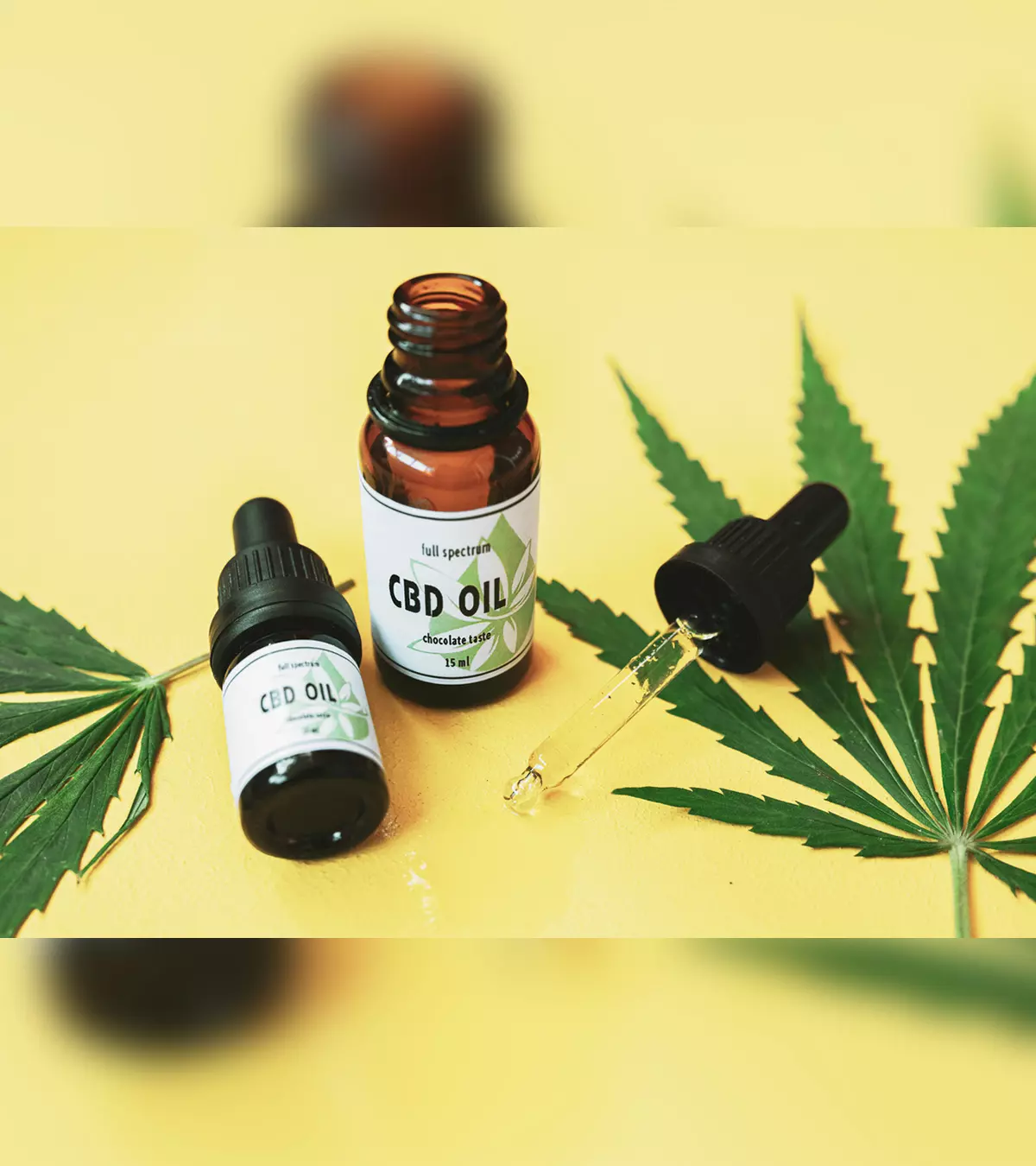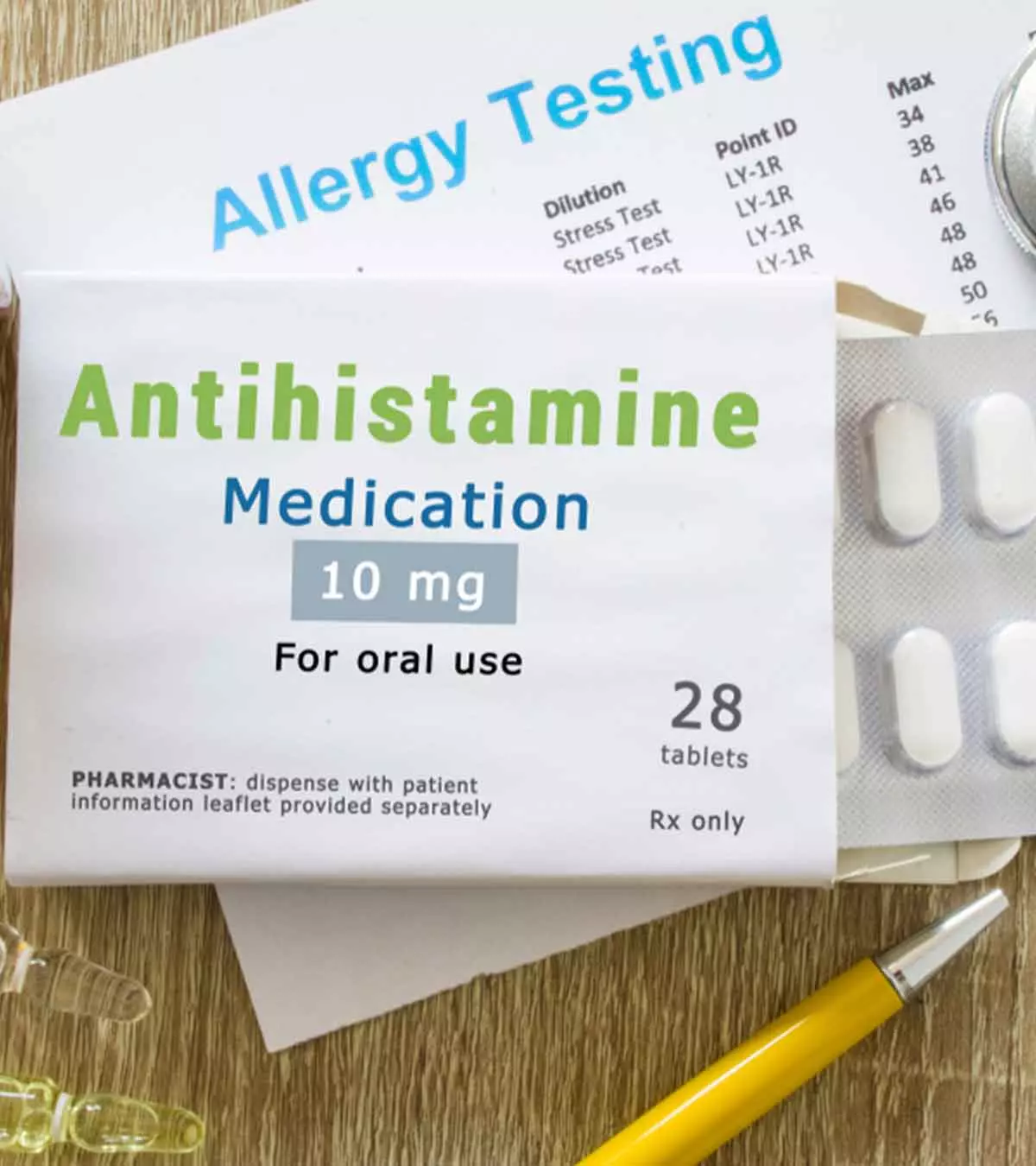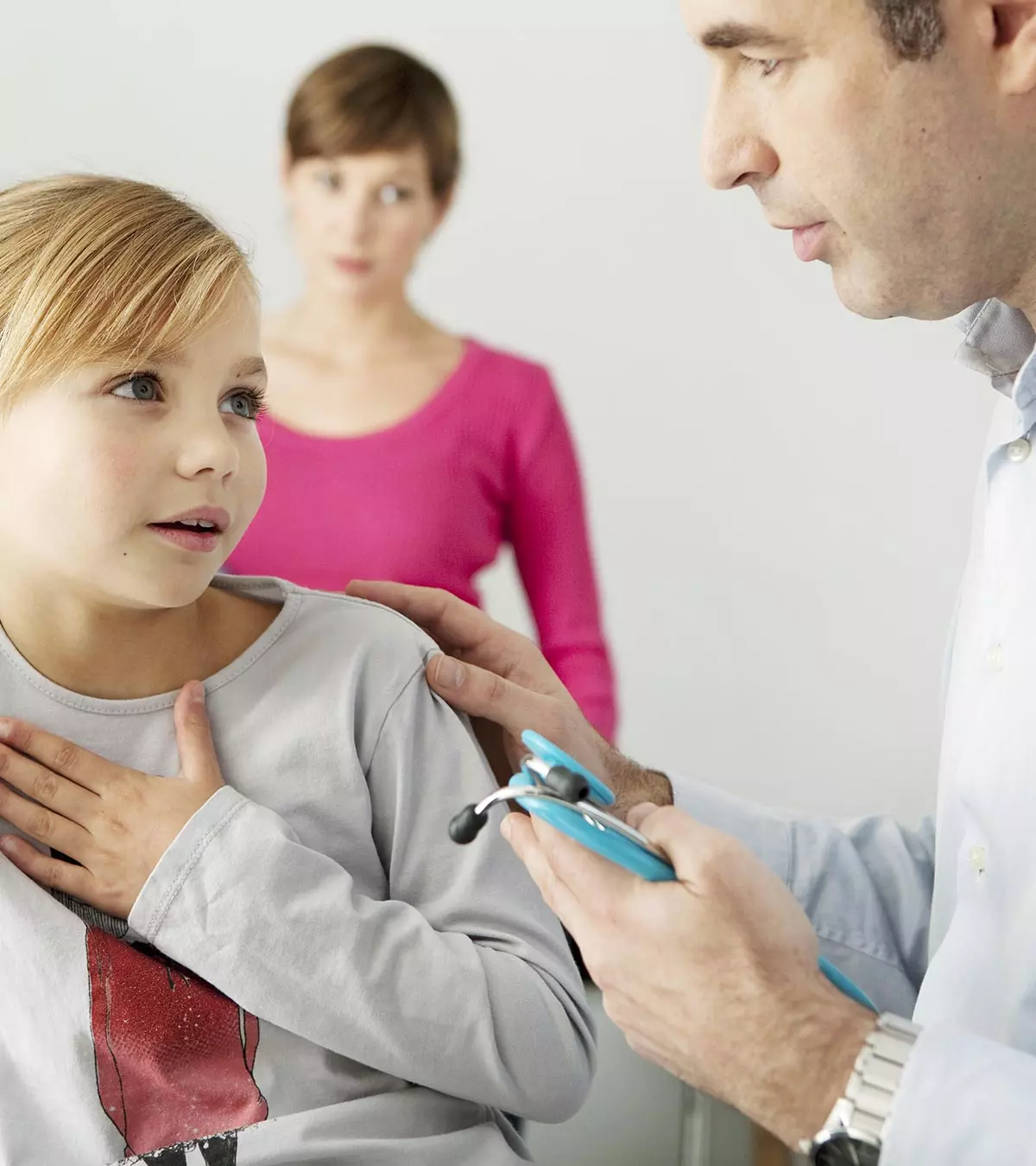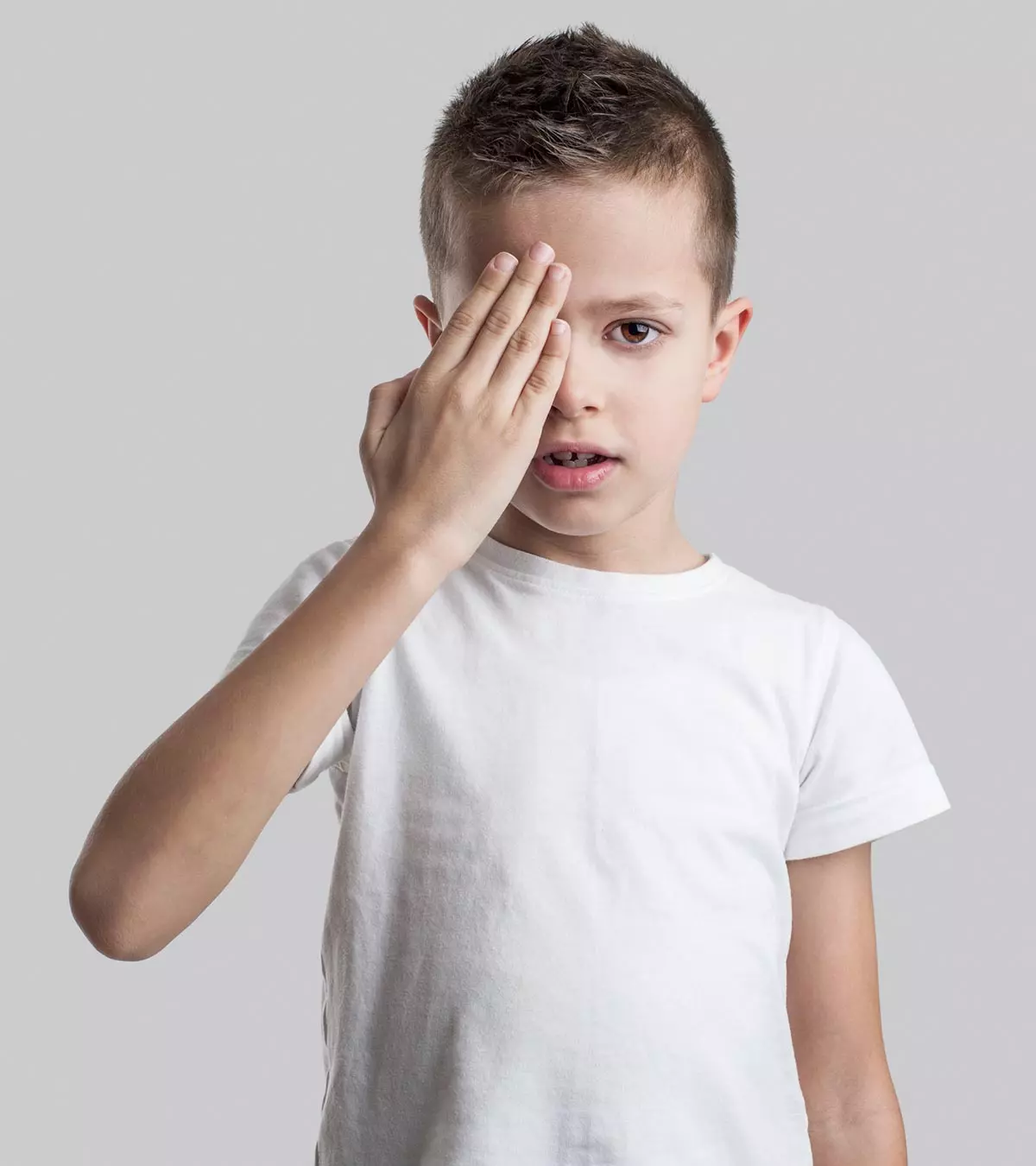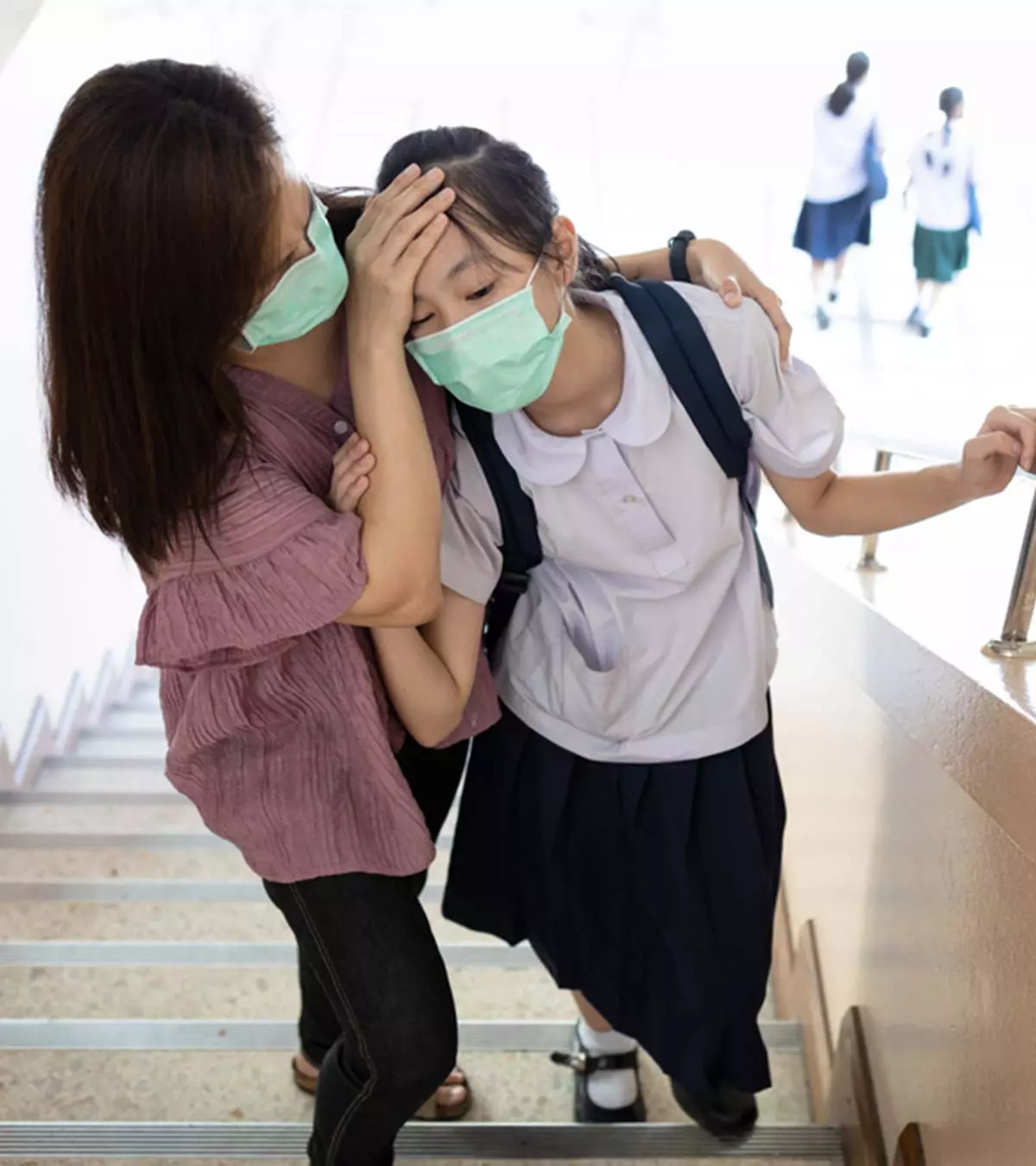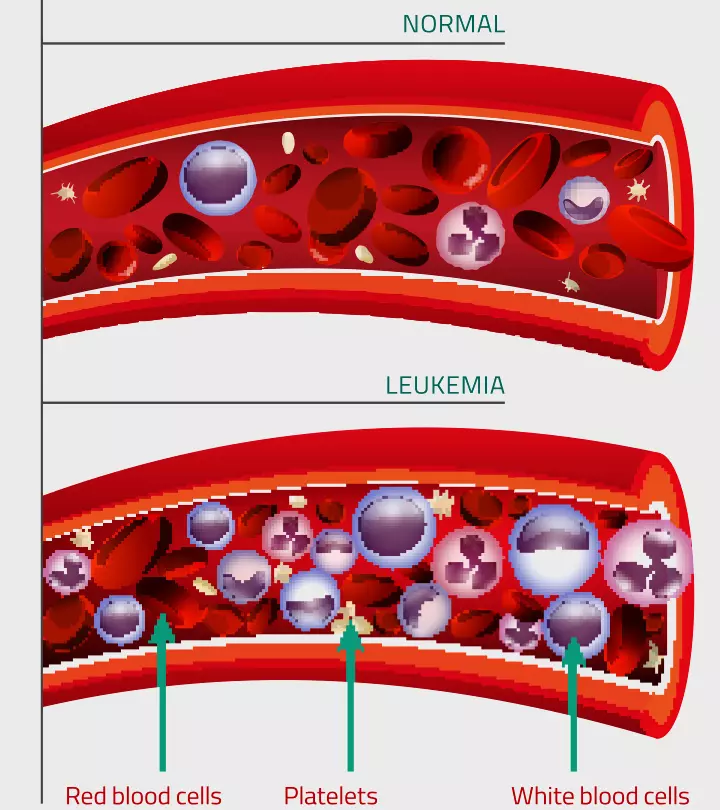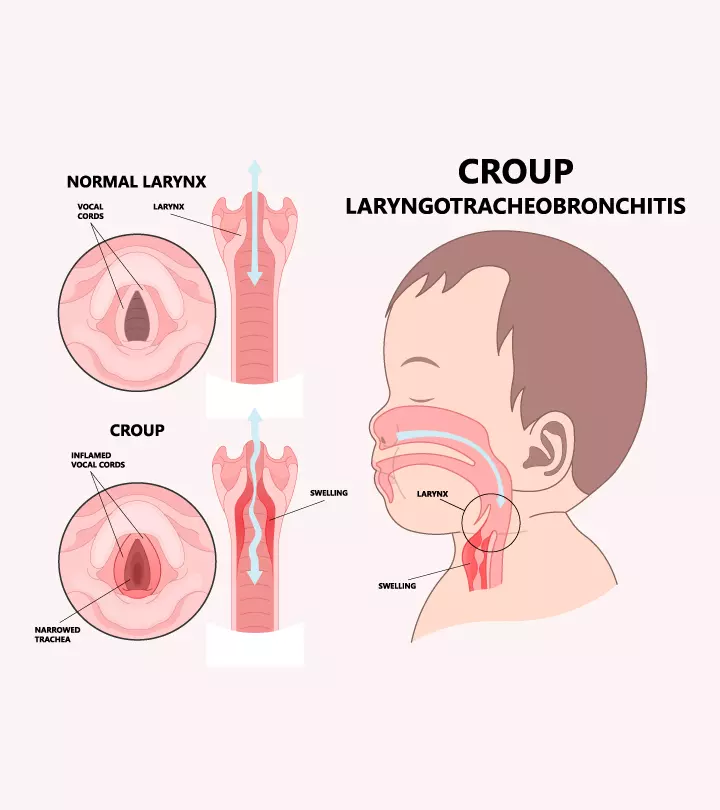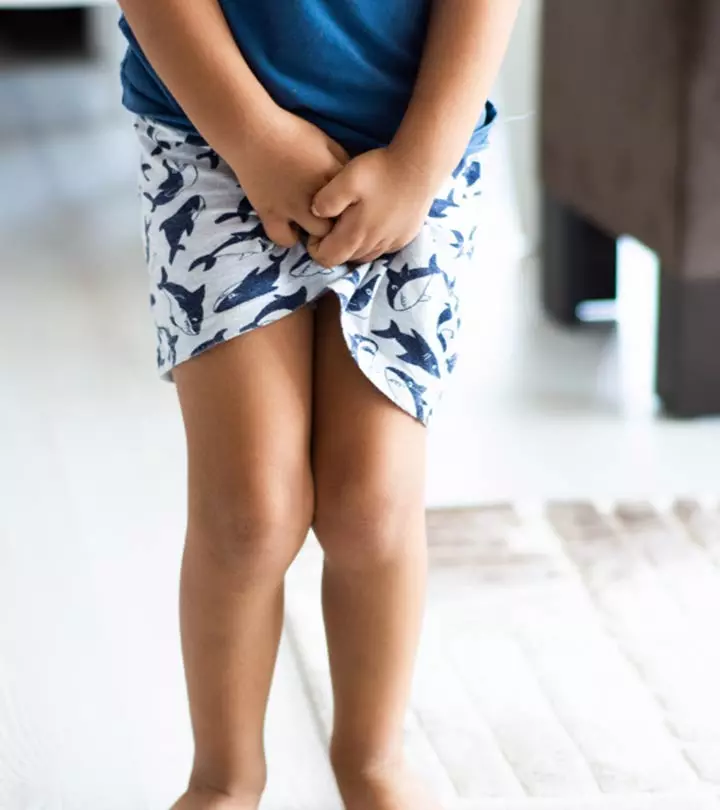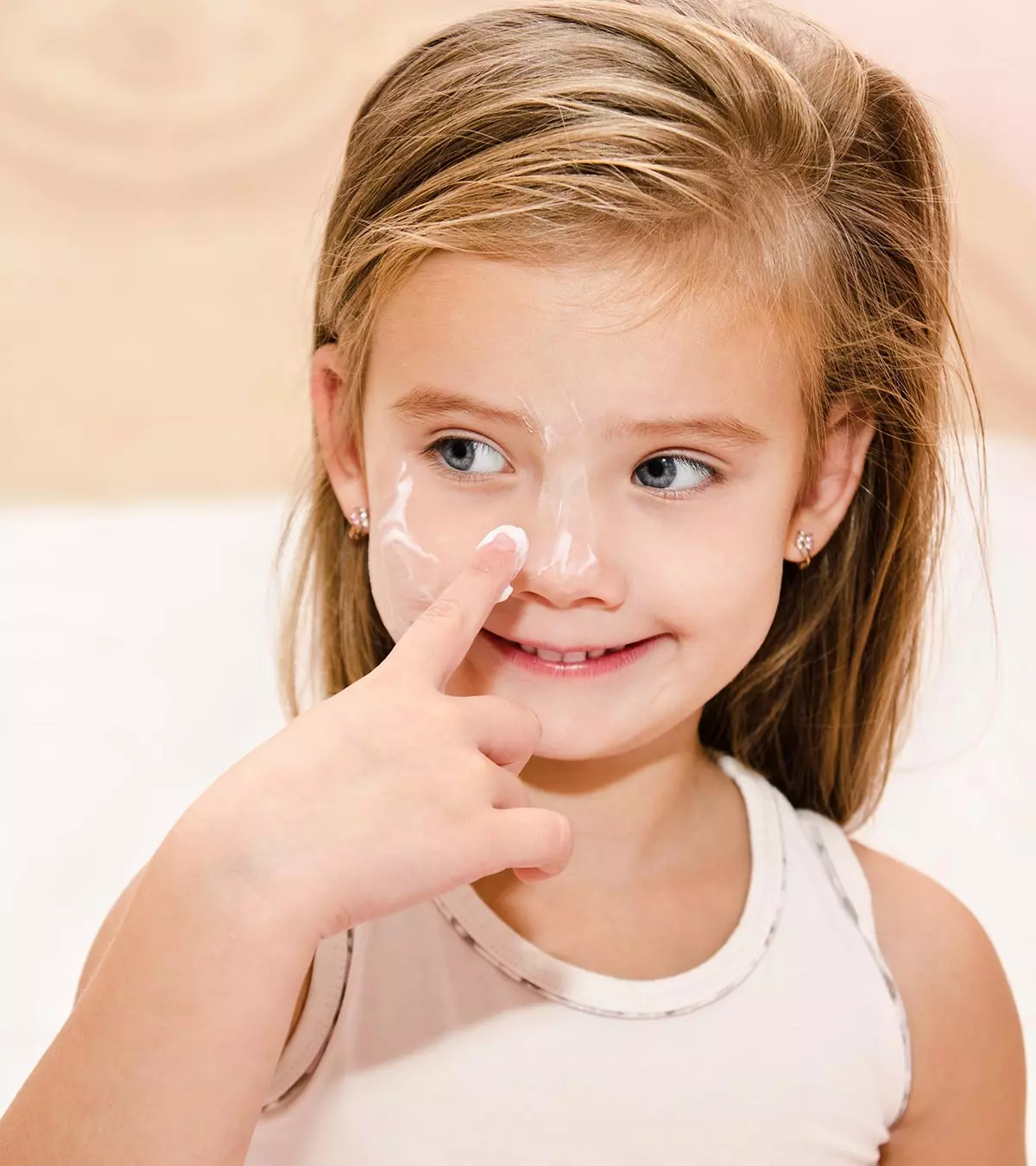
Image: ShutterStock
Dry skin in children is a common problem that may cause itchiness and skin irritation. The condition may worsen during winters due to reduced moisture content in the air, and the child may have to use a moisturizer multiple times a day. Dry skin, also called xerosis, may have several causes, such as extremes of weather, some skin products, inadequate hydration, or an underlying health condition. Read through this post as we explain what may cause children to develop dry skin and suggest some home remedies to manage the condition.

Key Pointers
- Dry skin in children is a common skin issue that can cause itching and irritation.
- Symptoms of dry skin include a rough appearance, mild scaling, pain, redness, and bleeding from cracks (in severe cases).
- Causes of dry skin in children include extreme weather, tight clothing, frequent bathing, dehydration, harsh soaps, sunburn, and allergies.
- More serious health conditions that can cause dry skin in children include nutritional deficiencies, Pityriasis alba, eczema, and psoriasis.
- Home treatments for dry skin in children include drinking enough water, using a humidifier, applying sunscreen, and avoiding scratching.
Symptoms Of Dry Skin In Children
Dry skin is most prominent on the arm, lower leg region, and the sides of the abdomen. The other symptoms vary based on the severity of the dryness. Some of the symptoms are:
Mildly dry skin
- Rough appearance and mild scaling of the skin
- Mild redness with no pain
Moderately dry skin
- Moderate scaling of the skin
- Mild or moderate itching and pain
- Mild redness
- Mild breakage and lines on the skin
Severely dry skin
- Severe scaling and itching
- Severe pain with redness and dry patches of skin
- Bleeding from the cracks of the skin (1)
Common Causes For Dry Skin In Children
Sometimes, mild to moderate dryness of skin could occur due to reasons that are not serious, and such dryness could be reduced with the use of home remedies and precautions. Dry skin in children is commonly due to (1):
- Extreme weather: Your child’s skin could become dry due to extreme cold or hot weather, which could cause a fall in humidity levels. As your child’s body loses excess water, the skin would become dry. This might cause cracks on the heels, and the skin on the sole of the feet might start to peel off.

- Air conditioning and heaters: Children who tend to spend more time indoors with air conditioning or heaters are also prone to dry skin. Air Conditioners and heaters tend to suck out the moisture from the air, which could be a reason for developing dry skin.
- Tight clothing: Wearing tight clothes can also induce or increase dry skin condition in children. The friction between the skin and clothes could aggravate the dryness of the skin.
- Frequent bathing and swimming: Taking long showers or baths in hot water, or swimming for long hours in chlorinated pools could deplete the lipid barrier of the skin, making it dry and scaly
- Dehydration: Not drinking enough water can also make your child’s skin dry; one of the prominent signs of dehydration is dry and chapped lips.
- Harsh soaps: The skin surface has a natural pH of 5 to 5.9 (6.34 to 7.5 in newborns), and using acidic or alkaline soaps can alter the skin’s pH and cause dryness. Also, many soaps and detergents strip off the natural lipids of the skin, which can also result in dryness. Using detergents and shampoos that are loaded with artificial chemicals can also dry out your child’s skin.
- Sunburn: Children tend to play outdoors in the sun, which can also cause dryness of the skin. Exposure to the ultraviolet rays of the sun could cause damage to the inner layers of the skin, causing redness, itching, and pain.
- Allergies: Environmental allergies or food allergies could aggravate dry skin conditions and cause itching, redness, or irritation.
Home Treatment For Common Dry Skin In Children
If your child has mild to moderately dry skin due to any of the above reasons, then it could be treated with these home care tips.
- Make sure your child drinks enough water throughout the day to stay hydrated.
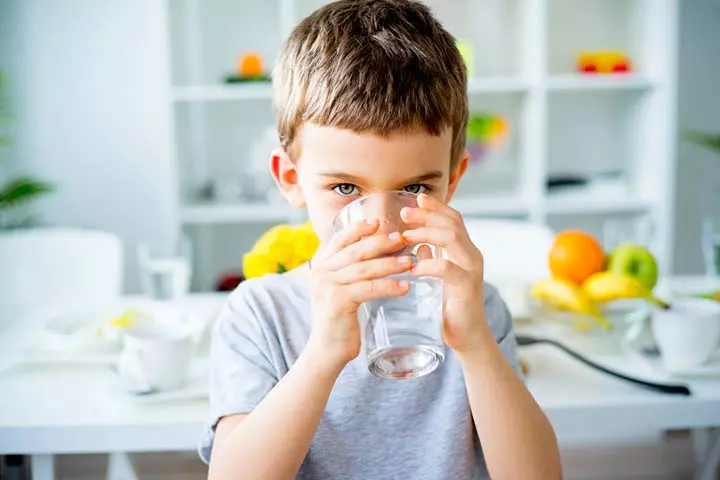
- During extreme weather conditions, try to limit the bathing time to ten minutes or less.
- Your child should inculcate good bathing habits such as using lukewarm water and avoiding the use of soap-containing chemicals.
- Apply a moisturizing cream or lotion on your child’s body as soon as they pat dry the body after a bath.
 Quick fact
Quick fact- If there is itching and scaling of the skin, you can apply a body lotion more frequently.
- If your child is spending more time indoors in air conditioners, then use a humidifier full time to help them stay hydrated.
- Before they jump into the pool, make sure they apply water-resistant moisturizing cream all over the body.
- Limit your child’s swimming time to 15-20 minutes and instruct them to take a bath right after swimming to wash off the excess chlorine, which could cause dryness of the skin.
- Encourage them to apply sunscreen on the areas that might get exposed to the sun.
- Do not let your children scratch the itchy and dry skin, as it can lead to bleeding and infection. Apply a cold compress instead to help soothe the itch.
- Apply moisturizer in places, such as the abdomen, armpits, kneecaps, etc., where there is more friction on the skin from the clothes. Make your child wear loose and light cotton clothing with minimum color, as dyes can cause itching in children with sensitive skin.
- If cracks on the feet are infected, antibiotic ointment could be applied three times a day, but after getting approval from your child’s doctor.
- Shallow and deep cracks could be sealed with the help of liquid bandages. These are available in pharmacies without any prescription, but make sure you do not use the ointment and liquid bandages together.
- You can also use a non-fragrant lip balm for chapped lips or thick petroleum jelly for the skin.
Usually, dry skin caused due to some of the above reasons subsides with these precautions and treatments within two weeks. If it does not, it could be an indication of an underlying condition.
When To Take Your Child To The Doctor
Dry skin is common in children and can be treated with simple home care tips. However, you should consider taking your child to a doctor if:
- The condition does not improve even after using home care tips
- You find that the dryness and scaling have increased
- There is pus and pain in the cracks of the skin
- When cracks have bleeding
The doctor would do a physical examination of your child’s skin and determine if the dryness is due to any medical conditions. Next, we will tell you about some of the medical conditions that can cause dryness of the skin in children.
Health Conditions That May Cause Dry Skin
- Nutritional deficiency: Usually, deficiencies in vitamin A can cause dry skin. One case report suggested that selenium deficiency can also cause dryness of the skin.
Other symptoms of vitamin deficiency include:
- Night blindness
- Oral ulcers
- Bleeding gums
- Bone tenderness
- BowlegsiOutward bending or curvature of knees, even when the ankles are together
- Knock knees
- Dry, brittle hair and hair fall (3)
Management: If your child’s dry skin is due to nutritional deficiency, then your doctor might advise you to include foods such as eggs, fish, orange and yellow fruits and vegetables, broccoli, spinach, and other dark leafy vegetables that are rich in vitamin A (4).
- Pityriasis alba: This is a common benign skin condition often occurring in children and teenagers and might cause scaling of the skin. According to researchers from LSU School of Medicine in Shreveport, Brookdale University, and Ochsner/LSU Health Monroe, it is estimated that around 5% of children in the United States may be affected by this condition. The most prominent symptom is round or oval patches on the child’s skin, with mild scaling and itching, mostly found on the cheeks, arms, and upper trunk. These circular patches could get hyperpigmented when exposed to the sun.
The specific cause for this skin condition is not yet known and tends to get resolved on its own. However, recovery time could range from a few months to one year. The scaling of the skin is more prominent due to winter dryness, when there is less humidity in the air.
Management: There is no specific cure for this skin condition. However, topical steroids, such as 1% hydrocortisoneiA steroid that works on the body’s immune system and helps reduce symptoms like redness, swelling, or itching , might help in reducing the redness and itching. You can also consider applying petroleum jelly and creams containing urea or lactic acidiA substance made from the sugars found in milk that is used in skin care products to soften and minimize wrinkles (5) (6).
- Eczema: Also known as atopic dermatitis, it is an autoimmune disease that usually starts during infancy or early childhood stage. The symptoms of eczema include extremely dry and scaly skin, redness, itching, and skin rashes in children. Yellow pus bumps also occur on the skin in extreme conditions. In children, these rashes occur in the folds of the elbows, hands, and knees. The skin might become thick with excessive scratching and rubbing.

According to the national eczema association, 50% of children who show signs of eczema develop other allergic reactions such as cough, wheezing, and shortness of breath, hay fever, and asthma (7).
Management: As this is an autoimmune disease, there is no specific cure for it. However, you can try and avoid the flare-ups by identifying the triggering allergen and keeping your child away from it. The available treatment options aim to reduce the symptoms and cure any secondary skin infections.
- Keratosis pilaris: This is another skin condition found in young children and can cause dry and rough skin. This condition is characterized by harmless tiny reddish bumps with dry and rough patches on the skin, which gives the child’s skin a chicken skin-like appearance.
These bumps predominantly occur on the upper arms, thighs, buttocks, and lateral sides of cheeks. The exact cause of this is unknown, but some studies state that the hormonal changes during puberty might be a reason.
Management: These are normally harmless, but if your child is feeling conscious about them, then you can contact your dermatologist. They may suggest soap-free cleansers, keratolyticsiSubstances used to remove the skin's outer layer and improve its ability to retain moisturized , and mild topical steroids that might help in reducing the symptoms (8).
- Psoriasis: This is another autoimmune disease that can cause extreme dryness and scaling of the skin. Genetics is found to play a major role as 90% of children who showed signs of psoriasis had a positive family history of psoriasis. It can also be triggered due to stress, streptococcal infections, and withdrawal of topical corticosteroidsiMedicines that may help reduce inflammation .
This skin disorder is characterized by oval or round patches on the skin that itch, and silvery-white scales.
Management:There is no specific treatment for psoriasis. It could only be managed with topical creams, emollients, and keratolytics that may help in reducing the symptoms (9). Some cases may be treated with phototherapy. Severe cases may require oral medicines.
 Point to consider
Point to considerHome Remedies For Dry Skin In Children
There are a few home remedies that you could try to help reduce dryness of skin in your children. While the effectiveness of these home remedies is not backed by scientific research, anecdotal evidence suggests that they may be able to provide relief from the dry skin caused by common or medical conditions.
- Natural oils: Nicole Lutze, a mother of two daughters, affirms the effectiveness of using natural oils to combat dry skin in her family during winter. She shares, “Since a midwife advised me to add a few drops of oil to my newborn baby’s bath almost six years ago, I’ve kept up the habit for all of our family members with lovely results…There are plenty of specific bath oils you can buy in shops (or online), but for the sake of simplicity and frugality, I use sweet almond oil or olive oil…To use the oil in the bath, just add an approximate teaspoon of oil as the tub fills up (i).”
Studies state that topical application of plant oils may act as a protective barrier to the skin, help retain moisture, and reduce the dryness. Hence, coconut oil, sunflower oil, grape seed oil, argan oil, soya bean oil, peanut oil, almond oil, etc., could help in reducing the dryness of the skin. These oils are also said to have anti-inflammatory properties that may be useful for reducing the redness and easing the pain (10).
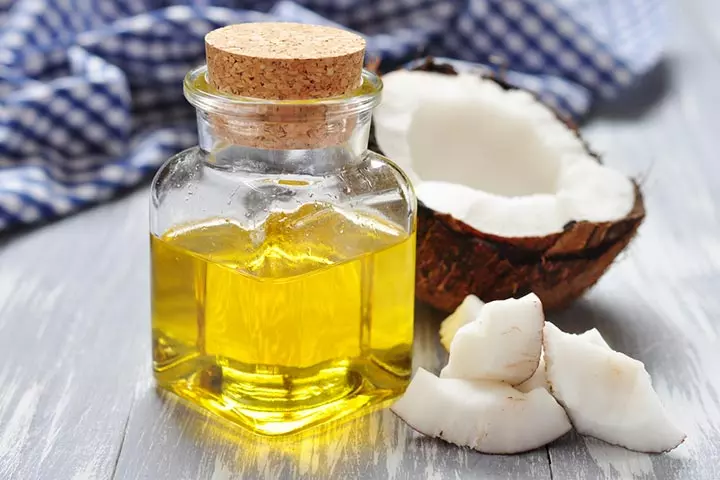
- Petroleum jelly: Moisturizing the skin regularly at the infant stage may help in reducing the severity of eczema in later stages of life. Also, a cost analysis showed that petroleum jelly is found to be a cost-effective moisturizer for a growing infant (11).
Also, according to the American Family Physician, petroleum jelly is a good skin lubricant, but care should be taken while applying it for children as it can get messy (12).
- Ghee: In ancient medicinal practices such as Ayurveda, ghee is used in the treatment of skin conditions. It is also believed that applying ghee to chapped lips might help to keep them moisturized (13).

- Oatmeal baths: Oatmeal baths are said to have a soothing effect on the irritated skin; also, colloidal oatmeal found in it is said to have moisturizing, cleansing, and anti-inflammatory properties (14).
According to a review, adding oatmeal directly to the bathwater and letting your children soak in it for 15-20 minutes could provide relief from inflammation and itchiness due to severely dry skin (15).
 Quick tip
Quick tipFrequently Asked Questions
1.What illnesses cause dry skin?
Some conditions that have dry skin as one of the symptoms include ichthyosis, psoriasis, atopic dermatitis, seborrheic dermatitis, and perioral dermatitis (16).
2. Which deficiency causes dry skin?
Dryness in the skin is mainly caused due to the deficiency of Vitamin B in the body (17).
3. What food should I avoid for dry skin?
Research has found multiple food allergies that trigger dermatitis, including dry skin. Hence, people should identify and avoid some food items such as peanuts, tree nuts, cow’s milk, eggs, soy, wheat, seafood, and shellfish that cause allergies (19).
4. What are the long-term effects of untreated dry skin in children?
If dry skin conditions are left untreated, they may lead to chronic skin ailments such as eczema and rashes. These may cause persistent itching and discomfort, and the skin can thicken due to constant scratching. The risk of skin infections may also increase due to cracking and bleeding.
Dry skin in children may be mild, moderate, or severe. You may notice a rough appearance of the skin, scaling, redness, or cracks. Children may experience dry skin due to extreme weather, heaters, tight clothing, and many other reasons. Your child’s skin health is important, so addressing these symptoms promptly is crucial. Encourage them to drink enough water, avoid chemical soaps, and use moisturizing creams to treat the condition. However, if these remedies do not work and you notice excess dryness, pain, and pus on the skin, you should consult a doctor. In most children, dry skin may not be a severe problem, but controlling it on time will reduce discomfort.
Infographic: Topical Ingredients To Manage Your Baby’s Dry Skin
One of the home remedial treatments suggested to help treat your little one’s dry skin is the use of body lotions and oils. But not all body lotions can be used for children as they might contain harmful chemicals. Therefore, in the following infographic, we list safe ingredients to be used on your child’s skin. Give it a read, and don’t forget to save it.
Some thing wrong with infographic shortcode. please verify shortcode syntax
Illustration: Dry Skin In Children: Causes Symptoms And Home Remedies
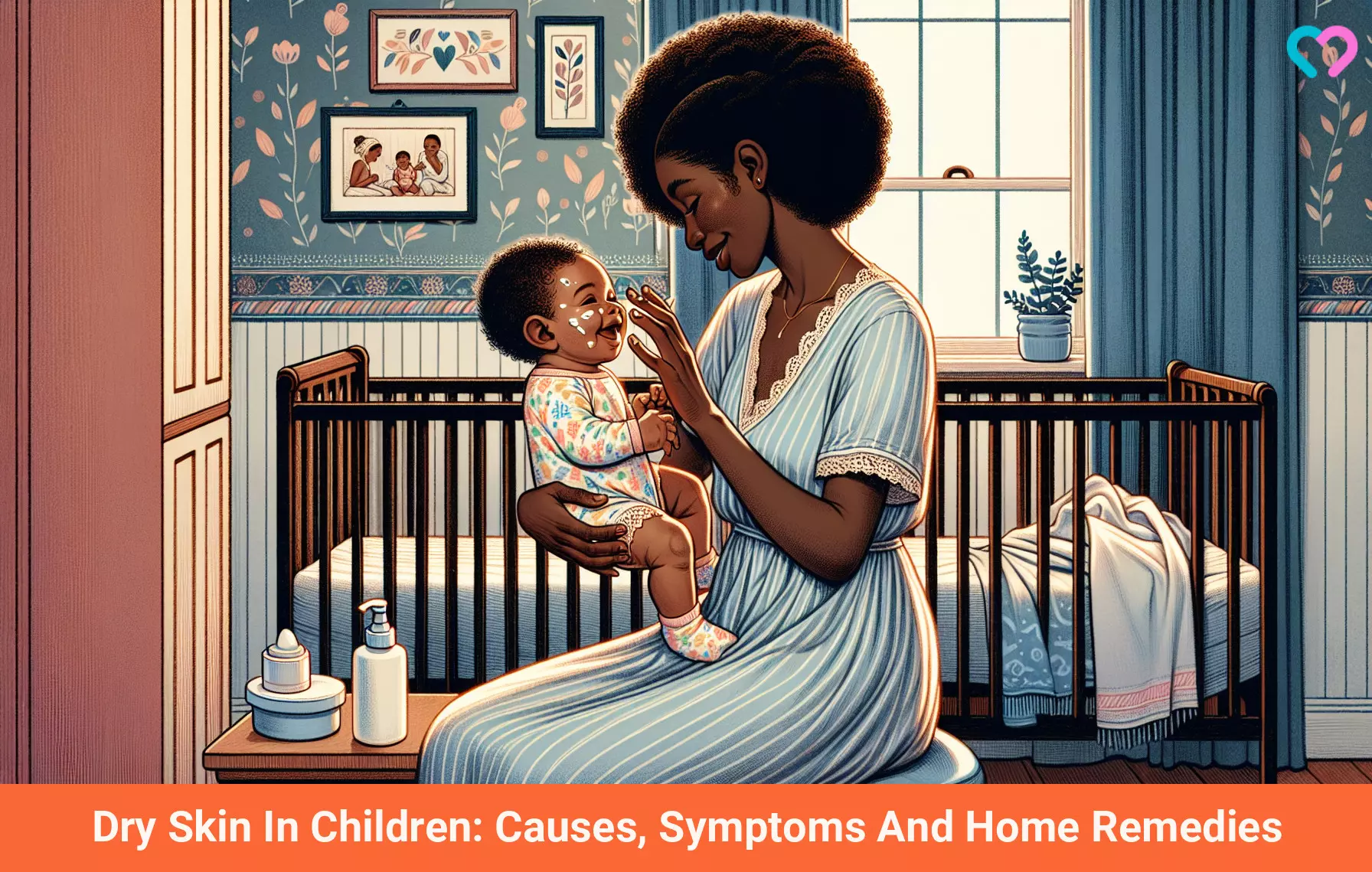
Image: Dall·E/MomJunction Design Team
Eczema in kids may be quite distressing to them. Learn about the causes, symptoms, treatments, and home management tips with this video.
Personal Experience: Source
MomJunction articles include first-hand experiences to provide you with better insights through real-life narratives. Here are the sources of personal accounts referenced in this article.
i. Oil baths, or, how to avoid dry skin in winter;https://thissimpleday.wordpress.com/2025/08/26/oil-baths-or-how-to-avoid-dry-skin-in-winter/
References:
1. Lyn Guenther, Chuck W Lynde, Anneke Andriessen, and Benjamin Barankin; Pathway to Dry Skin Prevention and Treatment; Research Gate
2. Choose Water for Healthy Hydration; Healthy Children
3. Meenal Batta, Naveenta Gupta, Geetika Goyal, and Amit Jain; Vitamin deficiency prevalence in primary school children in Punjab, India; Research Gate
4. Vitamin A; Medline Plus; US National Library of Medicine
5. Rob Danoff; A Pictorial Review of Primary Care Dermatology Pcom Board Review; Philadelphia University
6. Donald N. Givler; Hajira Basit; Amy Givler; Pityriasis Alba; NCBI
7. Atopic Dermatitis in Children; National Eczema Association
8. Heather Ciliberto, Arta Farshidi, David Berk, and Susan Bayliss; Photopneumatic Therapy for the Treatment of Keratosis Pilaris; Journal of Drugs In Dermatology
9. Jayakar Thomas, and Kumar Parimalam; Treating pediatric plaque psoriasis: challenges and solutions; NCBI
10. Tzu-Kai Lin, Lily Zhong, and Juan Luis Santiago; Anti-Inflammatory and Skin Barrier Repair Effects of Topical Application of Some Plant Oils; International Journal of Molecular Sciences
11. Shuai Xu et al.; Cost-effectiveness of Prophylactic Moisturization for Atopic Dermatitis; NCBI
12. What Can I Do for Dry, Itchy Skin?; American Family Physician
13. Hari Sharma, Xiaoying Zhang, and Chandradhar Dwivedi; The effect of ghee (clarified butter) on serum lipid levels and microsomal lipid peroxidation; An International Quarterly Journal of Research in Ayurveda
14. Maryline Criquet, Romain Roure, Liliane Dayan,Virginie Nollent, and Christiane Bertin; Safety and efficacy of personal care products containing colloidal oatmeal; NCBI
15. Nader Pazyar, Reza Yaghoobi, Afshin Kazerouni, Amir Feily; Oatmeal in dermatology: A brief review; Indian Journal of Dermatology Venereology and Leprology
16. Dry skin: Who gets and causes; American Academy Of Dermatology Association
17. B Vitamins: Your Secret To Good Skin Health; Tri-City Medical Center
18. Dry Skin; Raising Children Network, Australia
19. Diet and Dermatitis: Food Triggers
Community Experiences
Join the conversation and become a part of our nurturing community! Share your stories, experiences, and insights to connect with fellow parents.
Read full bio of Dr. Shaon Mitra
Read full bio of Dr. Ritika Shah
Read full bio of Swati Patwal
Read full bio of Ghazia Shah





